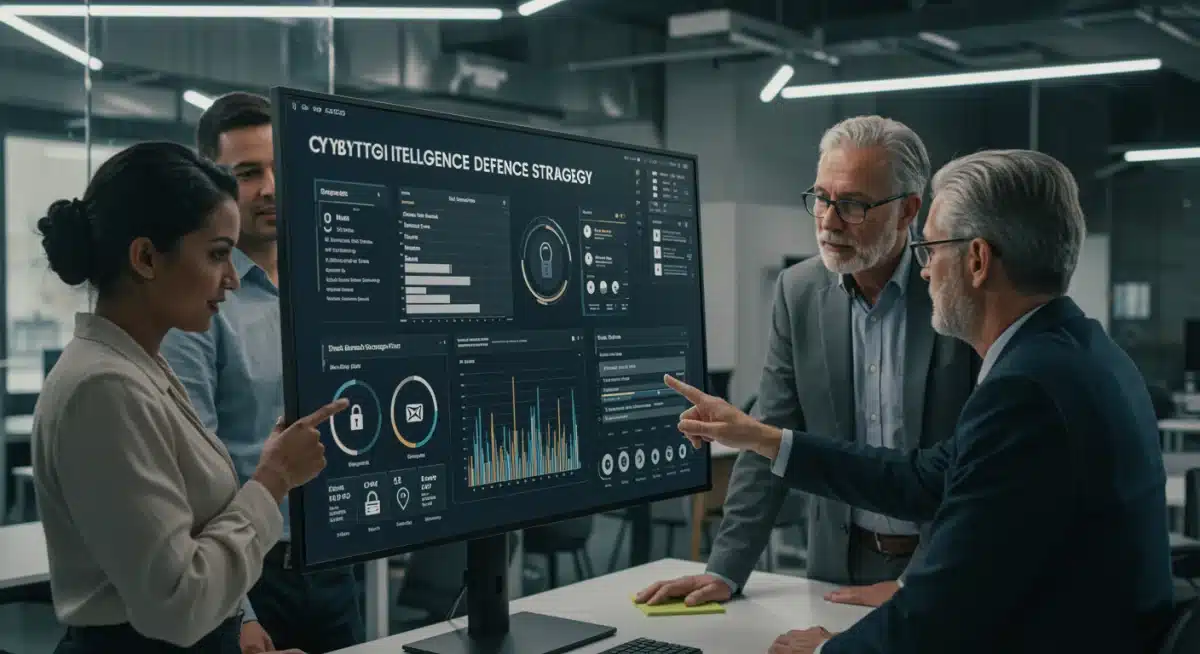Cybersecurity Threats 2025: U.S. Business Guide to Digital Asset Protection

For U.S. businesses, navigating cybersecurity threats 2025 demands proactive strategies and practical solutions to safeguard digital assets from emerging risks, ensuring operational continuity and data integrity.
As we approach 2025, the landscape of digital threats continues to evolve at an unprecedented pace, presenting significant challenges for U.S. businesses. Protecting digital assets is no longer just an IT concern; it’s a fundamental business imperative. This guide provides a critical overview of the most pressing cybersecurity threats 2025 and offers actionable strategies to fortify your defenses.
The Evolving Landscape of Cyber Threats in 2025
The digital realm is a constant battlefield, and in 2025, the adversaries are more sophisticated, persistent, and globally distributed than ever before. U.S. businesses face an array of threats that are not only increasing in volume but also in their complexity and potential for devastating impact. Understanding the current threat model is the first step in building resilient defenses.
New technologies, while offering immense opportunities, also introduce novel vulnerabilities. The rapid adoption of AI, IoT, and cloud-native architectures means that attack surfaces are expanding, and traditional security measures may no longer be sufficient. Organizations must adapt their security posture to match this dynamic environment, moving from reactive responses to proactive, intelligence-driven defense.
Key Drivers of Cyber Threat Evolution
- AI-powered Attacks: Adversaries are leveraging artificial intelligence and machine learning to automate attacks, create highly convincing phishing campaigns, and exploit zero-day vulnerabilities more efficiently.
- Supply Chain Vulnerabilities: Attacks increasingly target weaker links within the supply chain, compromising trusted third-party vendors to gain access to primary targets.
- Geopolitical Tensions: Nation-state actors and state-sponsored groups are intensifying their cyber espionage and sabotage efforts, often targeting critical infrastructure and key industries.
The convergence of these factors creates a challenging environment where businesses must be constantly vigilant. Staying informed about the latest attack methodologies and threat intelligence is crucial for maintaining a strong defensive stance against the evolving cybersecurity threats 2025.
Risk 1: Advanced Persistent Threats (APTs) and Ransomware 2.0
Advanced Persistent Threats (APTs) continue to be a top concern, characterized by their stealth, persistence, and focus on high-value targets. In 2025, APTs are not just about data exfiltration; they are increasingly intertwined with sophisticated ransomware campaigns, often referred to as Ransomware 2.0. These attacks are no longer simple encryption-for-cash schemes; they involve data exfiltration, double extortion, and even direct operational disruption, making them far more damaging.
Ransomware groups are evolving their tactics to include meticulous reconnaissance, exploiting vulnerabilities in remote work setups, and leveraging stolen credentials. The average downtime and recovery costs associated with these attacks are skyrocketing, posing an existential threat to businesses that are unprepared. The shift towards ‘big game hunting’ by ransomware gangs means smaller organizations are not immune; they can be targets as part of a larger supply chain attack or simply due to perceived weaker defenses.
Practical Solutions Against APTs and Ransomware 2.0
- Enhanced Endpoint Detection and Response (EDR)/Extended Detection and Response (XDR): Deploy advanced EDR/XDR solutions that use AI and behavioral analytics to detect and respond to suspicious activities across endpoints, networks, and cloud environments.
- Zero Trust Architecture: Implement a Zero Trust model where no user or device is trusted by default, regardless of whether they are inside or outside the network perimeter. This requires strict verification for every access attempt.
- Immutable Backups and Disaster Recovery: Ensure critical data is backed up to immutable storage locations, making it impossible for attackers to alter or delete. Regularly test your disaster recovery plans to ensure rapid restoration capabilities.
- Employee Training and Awareness: Conduct frequent and realistic security awareness training, focusing on identifying phishing attempts, social engineering tactics, and safe browsing practices.
Mitigating these complex threats requires a multi-layered approach that integrates technology, processes, and people. Businesses must prioritize investment in robust security frameworks and continuous monitoring to stay ahead of these increasingly sophisticated cybersecurity threats 2025.
Risk 2: AI-Powered Social Engineering and Deepfakes
The proliferation of artificial intelligence, while beneficial in many aspects, has also armed cybercriminals with powerful new tools. In 2025, AI-powered social engineering and deepfake technology represent a significant escalation in the sophistication of phishing, vishing (voice phishing), and business email compromise (BEC) attacks. These techniques exploit human psychology by creating highly credible and personalized deceptions that are incredibly difficult to detect.
AI can analyze vast amounts of public data to craft highly personalized phishing emails that mimic legitimate communications, making them incredibly effective. Deepfake technology, using AI to generate realistic fake audio and video, can be used to impersonate executives or trusted individuals, tricking employees into transferring funds or divulging sensitive information. The realism of these deepfakes makes traditional verification methods challenging, introducing a new layer of deception into the threat landscape.

Countering AI-Driven Deception
Addressing AI-powered social engineering and deepfakes requires a combination of advanced technological defenses and heightened human vigilance. Businesses cannot rely solely on email filters or basic awareness training; a more nuanced approach is essential to combat these evolving cybersecurity threats 2025.
Strengthening Human Defenses
- Advanced Security Awareness Training: Focus training on recognizing subtle cues in AI-generated content, verifying requests through multiple channels (e.g., calling back using a known number, not one provided in an email), and understanding the risks of deepfakes.
- Multi-Factor Authentication (MFA) Everywhere: Implement MFA for all critical systems and accounts. Even if credentials are compromised through social engineering, MFA acts as a crucial second line of defense.
Leveraging Technology for Detection
Utilize AI-powered security solutions that specialize in detecting anomalies in communication patterns, identifying deepfake indicators in multimedia content, and flagging unusual transaction requests. These tools can provide an automated layer of defense against sophisticated deception. Organizations should also establish clear protocols for verifying high-value transactions or unusual requests, ensuring that multiple checks are in place before any action is taken. This systematic approach reduces the likelihood of falling victim to advanced social engineering tactics.
Risk 3: IoT Vulnerabilities and Edge Computing Exploits
The proliferation of Internet of Things (IoT) devices and the rise of edge computing are expanding the attack surface dramatically for U.S. businesses. From smart office devices and industrial control systems (ICS) to remote sensors and wearable technology, IoT devices often lack robust security features, making them attractive entry points for cybercriminals. These devices can be exploited to gain network access, launch DDoS attacks, or serve as vectors for lateral movement within an organization’s infrastructure.
Edge computing, which processes data closer to the source, introduces new security challenges. While it offers benefits in terms of speed and efficiency, it also means that sensitive data and critical processing occur outside the traditional hardened corporate perimeter. Securing these distributed environments against the unique cybersecurity threats 2025 requires a comprehensive and scalable security strategy that accounts for the diverse nature of edge devices and their operating environments.
Securing IoT and Edge Computing Environments
Protecting IoT and edge computing assets requires a dedicated security strategy that addresses their specific vulnerabilities and operational contexts. Generic security measures are often insufficient for these specialized environments.
Comprehensive Device Management and Security
- Device Inventory and Lifecycle Management: Maintain a complete inventory of all IoT devices, track their lifecycle from deployment to decommissioning, and ensure all devices are patched and configured securely.
- Network Segmentation: Isolate IoT devices on separate network segments to limit their access to critical business systems and prevent lateral movement in case of a compromise.
- Secure Configuration and Patch Management: Enforce strong default security configurations, disable unnecessary services, and implement a rigorous patch management program for all IoT and edge devices.
Edge Security Best Practices
Implement security-by-design principles for all edge deployments, ensuring that security is integrated from the initial planning stages. This includes secure boot, hardware-based root of trust, and encrypted communications. Continuous monitoring of edge devices for anomalies and suspicious behavior is also essential. Organizations should leverage specialized security solutions designed for IoT and edge environments that can provide visibility, threat detection, and automated response capabilities, ensuring that these expanding digital boundaries are adequately protected against the cybersecurity threats 2025.
Building a Resilient Cybersecurity Posture
In the face of escalating cybersecurity threats 2025, U.S. businesses must adopt a holistic and adaptive approach to security. A resilient cybersecurity posture goes beyond simply implementing tools; it involves fostering a culture of security, continuous improvement, and strategic planning. Businesses need to understand that cybersecurity is not a one-time fix but an ongoing process that requires constant attention and investment.
This includes regular vulnerability assessments, penetration testing, and red teaming exercises to identify weaknesses before attackers do. Developing comprehensive incident response plans and regularly rehearsing them ensures that your organization can effectively mitigate the impact of a breach. Furthermore, collaboration with industry peers and government agencies can provide valuable threat intelligence and best practices, enhancing collective defense capabilities.
Key Pillars of Resilience
- Cybersecurity Governance: Establish clear policies, roles, and responsibilities for cybersecurity, integrating it into overall business risk management.
- Threat Intelligence Integration: Continuously gather and integrate threat intelligence to proactively identify and mitigate emerging risks.
- Security Automation and Orchestration: Leverage security automation to streamline security operations, reduce response times, and minimize human error.
By focusing on these pillars, businesses can build a robust defense mechanism that is capable of withstanding the complex and dynamic nature of cybersecurity threats 2025. Proactive investment and strategic planning are paramount for safeguarding digital assets in the coming years.
Regulatory Compliance and Legal Implications in 2025
The increasing sophistication of cybersecurity threats 2025 is directly impacting the regulatory landscape for U.S. businesses. Compliance with evolving data privacy laws, industry-specific regulations, and new federal mandates is becoming more stringent and complex. Non-compliance can result in severe financial penalties, reputational damage, and legal repercussions, adding another layer of risk to an already challenging environment.
Businesses must stay abreast of new legislation and ensure their cybersecurity practices meet or exceed regulatory requirements. This often involves detailed record-keeping, regular audits, and transparent reporting mechanisms. The focus is shifting towards accountability, with executives increasingly held responsible for their organization’s cybersecurity posture and incident response capabilities.
Navigating the Regulatory Maze
Understanding and adhering to the various regulatory frameworks is crucial for U.S. businesses. Failure to do so not only exposes organizations to legal and financial risks but also erodes customer trust, a critical asset in the digital economy.
Key Regulatory Considerations
- Data Privacy Laws: Adherence to state-level privacy laws (e.g., CCPA, CPRA) and potential federal privacy legislation, which dictate how personal data is collected, stored, and processed.
- Industry-Specific Regulations: Compliance with frameworks like HIPAA for healthcare, PCI DSS for payment card data, and NIST standards for federal contractors.
- Incident Reporting Mandates: New requirements for timely reporting of cyber incidents to government agencies and affected individuals, emphasizing transparency and rapid response.
Proactive engagement with legal counsel and cybersecurity experts is essential to navigate this complex regulatory environment. Establishing a robust compliance program that is regularly reviewed and updated will help businesses avoid penalties and build trust with their customers and partners, especially concerning the evolving cybersecurity threats 2025.
The Role of Cloud Security in Mitigating 2025 Threats
Cloud computing continues to be a cornerstone of modern business operations, offering scalability, flexibility, and cost efficiency. However, the migration of critical data and applications to the cloud also introduces unique security challenges that U.S. businesses must address in 2025. While cloud providers offer robust infrastructure security, responsibility for data security and application-level protection often falls on the customer. Misconfigurations, identity and access management (IAM) failures, and insecure APIs are common vulnerabilities that cybercriminals actively exploit.
In 2025, cloud environments will be increasingly targeted by sophisticated actors who understand the nuances of cloud architectures. The shared responsibility model can sometimes lead to confusion and gaps in security coverage, making it imperative for businesses to have a clear understanding of their obligations and to implement appropriate controls to protect their cloud assets from the pervasive cybersecurity threats 2025.

Cloud Security Best Practices
Effective cloud security requires a dedicated strategy that aligns with the specific services and platforms being utilized. It’s not enough to assume the cloud provider handles everything; businesses must actively manage their cloud security posture.
Essential Cloud Security Measures
- Strong Identity and Access Management (IAM): Implement granular access controls, enforce the principle of least privilege, and use MFA for all cloud accounts.
- Cloud Security Posture Management (CSPM): Utilize CSPM tools to continuously monitor cloud configurations for misconfigurations, compliance violations, and security risks.
- Data Encryption: Encrypt all data at rest and in transit within cloud environments, using strong encryption protocols and managing encryption keys securely.
Beyond these technical controls, businesses must also ensure they have clear visibility into their cloud environments, including logs and activity monitoring, to detect and respond to threats rapidly. Regular security audits and penetration testing of cloud-based applications are also critical. By proactively addressing cloud security, U.S. businesses can leverage the benefits of the cloud while effectively mitigating the associated cybersecurity threats 2025, transforming potential vulnerabilities into secure operational advantages.
Key Threat Area |
Practical Solution Highlight |
|---|---|
APTs & Ransomware 2.0 |
Implement Zero Trust and Immutable Backups. |
AI Social Engineering |
Boost advanced employee training and MFA. |
IoT & Edge Exploits |
Utilize network segmentation and secure configurations. |
Cloud Vulnerabilities |
Strengthen IAM and CSPM for cloud assets. |
Frequently Asked Questions on Cybersecurity Threats in 2025
U.S. businesses in 2025 primarily face Advanced Persistent Threats and Ransomware 2.0, AI-powered social engineering and deepfakes, and vulnerabilities within IoT devices and edge computing environments. These threats demand sophisticated, multi-layered defense strategies.
Protection involves advanced security awareness training for employees to recognize subtle AI-generated deceptions, mandatory Multi-Factor Authentication (MFA) across all systems, and deploying AI-powered security tools capable of detecting communication anomalies and deepfakes.
Zero Trust architecture is crucial as it assumes no entity, inside or outside the network, is inherently trustworthy. It requires continuous verification for all access attempts, significantly reducing the risk of lateral movement by attackers in case of a breach.
Yes, IoT devices are a major concern due to their often-weak security features and expanding presence. They can serve as easy entry points for attackers. Businesses must implement strong inventory management, network segmentation, and rigorous patch management for these devices.
Regulatory compliance is critically important. Non-compliance with evolving data privacy laws, industry-specific regulations, and new federal mandates can lead to severe financial penalties, reputational damage, and legal issues. Proactive engagement with legal and cybersecurity experts is essential.
Looking Ahead
The intensifying cybersecurity threats 2025 demand immediate and sustained attention from U.S. businesses. The solutions outlined in this guide represent not just best practices, but essential survival strategies for the digital economy. Organizations must now integrate advanced technologies, foster a culture of security, and stay agile in adapting to new threats. Continuous vigilance, strategic investment, and proactive defense will define success in safeguarding digital assets against an ever-evolving adversary landscape.





